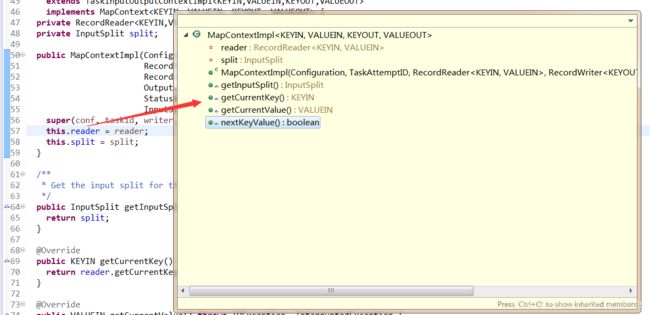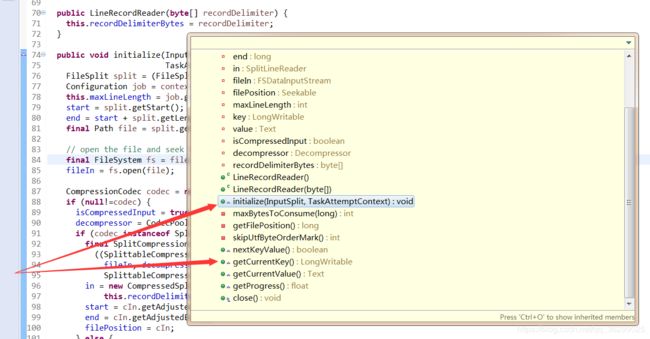从源码的角度分析MapReduce的map-input流程
前言
之前我们对MapReduce中Client提交Job作业的流程进行了源码分析(点击查看Client提交Job作业源码分析),今天我们来分析一下map-input阶段的源码。
源码位置
hadoop部署包下的hadoop-mapreduce-client-core-2.6.5.jar ,org.apache.hadoop.mapred包下有2个要看的:maptask和reducetask
1.Mapper类中的run()方法
从context中取出Key、Value给到map。
public void run(Context context) throws IOException, InterruptedException {
setup(context);
try {
while (context.nextKeyValue()) {
map(context.getCurrentKey(), context.getCurrentValue(), context);
}
} finally {
cleanup(context);
}
}
1.1MapTask类中的run()方法:
MapTask中根本没有main方法,是被被容器反射变成对象,然后调自己的run()方法。
首先对配置信息中取出来的ReduceTask的数量进行判断,为0就把资源全部给Map。否则,就会有Map和Sort,且资源配比为2:1。当然,我们在Client提交作业之前,可以通过配置ReduceTask的数量:job.setNumReduceTasks(99);
@Override
public void run(final JobConf job, final TaskUmbilicalProtocol umbilical)
throws IOException, ClassNotFoundException, InterruptedException {
this.umbilical = umbilical;
if (isMapTask()) {
// If there are no reducers then there won't be any sort. Hence the map
// phase will govern the entire attempt's progress.
//从配置信息中取出来的ReduceTask的数量如果为0,即没有Reduce
if (conf.getNumReduceTasks() == 0) {
mapPhase = getProgress().addPhase("map", 1.0f);
} else {
// If there are reducers then the entire attempt's progress will be
// split between the map phase (67%) and the sort phase (33%).
mapPhase = getProgress().addPhase("map", 0.667f);
sortPhase = getProgress().addPhase("sort", 0.333f);
}
}
TaskReporter reporter = startReporter(umbilical);
boolean useNewApi = job.getUseNewMapper();
initialize(job, getJobID(), reporter, useNewApi);
// check if it is a cleanupJobTask
if (jobCleanup) {
runJobCleanupTask(umbilical, reporter);
return;
}
if (jobSetup) {
runJobSetupTask(umbilical, reporter);
return;
}
if (taskCleanup) {
runTaskCleanupTask(umbilical, reporter);
return;
}
//判断是否使用新的api
if (useNewApi) {
runNewMapper(job, splitMetaInfo, umbilical, reporter);
} else {
runOldMapper(job, splitMetaInfo, umbilical, reporter);
}
done(umbilical, reporter);
}
2.RunNewMapper方法:
值得我们注意的是方法底部的try catch块。
map阶段大概要做的事就是:
- 进行输入初始化,经历了输入初始化后,才会调用mapper的run方法(也就是Mapper类中的run方法)。
- 框架最终是把Mapper中的run方法调起来了。run()方法执行完了,代表没有数据可处理了,于是就map阶段就结束了。
- 然后input关闭,并置空。关闭output、置空(output的关闭里,包含了刷新)。
@SuppressWarnings("unchecked")
private <INKEY,INVALUE,OUTKEY,OUTVALUE>
void runNewMapper(final JobConf job,
final TaskSplitIndex splitIndex,
final TaskUmbilicalProtocol umbilical,
TaskReporter reporter
) throws IOException, ClassNotFoundException,
InterruptedException {
// make a task context so we can get the classes
//任务上下文taskContext,里面包装了job对象。Client把jar包提交到HDFS了,MapTask
//跑起来后要把jar包、配置信息下载回本地的,因此此时job对象里的配置信息和我们当初
//一通set的配置信息是一样的。
org.apache.hadoop.mapreduce.TaskAttemptContext taskContext =
new org.apache.hadoop.mapreduce.task.TaskAttemptContextImpl(job,
getTaskID(),
reporter);
// make a mapper
//隐性理解为配置信息要取MapperClass,根据我们在配置中指定的自定义Mapper类,反射出具体的
//Mapper类对象。换句话说,经过反射得到的Mapper对象,就是我们自定义Mapper对象
org.apache.hadoop.mapreduce.Mapper<INKEY,INVALUE,OUTKEY,OUTVALUE> mapper =
(org.apache.hadoop.mapreduce.Mapper<INKEY,INVALUE,OUTKEY,OUTVALUE>)
ReflectionUtils.newInstance(taskContext.getMapperClass(), job);
// make the input format
//输入格式化,Client也用到了输入格式化FileInputFormat,用来计算切片清单
org.apache.hadoop.mapreduce.InputFormat<INKEY,INVALUE> inputFormat =
(org.apache.hadoop.mapreduce.InputFormat<INKEY,INVALUE>)
ReflectionUtils.newInstance(taskContext.getInputFormatClass(), job);
// rebuild the input split
//重建切片(一个),一个split切片对应一个maptask。MapTask运行的时候,
//它要把它的切片信息重构为一个对象,因为Client把切片信息序列化了,map环节
//要反序列化才行
org.apache.hadoop.mapreduce.InputSplit split = null;
split = getSplitDetails(new Path(splitIndex.getSplitLocation()),
splitIndex.getStartOffset());
LOG.info("Processing split: " + split);
//构造,new一个记录读取器,传参:切片、输入格式化类
org.apache.hadoop.mapreduce.RecordReader<INKEY,INVALUE> input =
new NewTrackingRecordReader<INKEY,INVALUE>
(split, inputFormat, reporter, taskContext);
job.setBoolean(JobContext.SKIP_RECORDS, isSkipping());
org.apache.hadoop.mapreduce.RecordWriter output = null;
// get an output object
if (job.getNumReduceTasks() == 0) {
output =
new NewDirectOutputCollector(taskContext, job, umbilical, reporter);
} else {
output = new NewOutputCollector(taskContext, job, umbilical, reporter);
}
//构造mapContext,有了上下文
org.apache.hadoop.mapreduce.MapContext<INKEY, INVALUE, OUTKEY, OUTVALUE>
mapContext =
new MapContextImpl<INKEY, INVALUE, OUTKEY, OUTVALUE>(job, getTaskID(),
input, output,
committer,
reporter, split);
org.apache.hadoop.mapreduce.Mapper<INKEY,INVALUE,OUTKEY,OUTVALUE>.Context
mapperContext =
new WrappedMapper<INKEY, INVALUE, OUTKEY, OUTVALUE>().getMapContext(
mapContext);
try {
//输入初始化
input.initialize(split, mapperContext);
//调用的是Mapper的run()方法,mapperContext作为参数给到run方法,run又给到map输出
mapper.run(mapperContext);
mapPhase.complete();
setPhase(TaskStatus.Phase.SORT);
statusUpdate(umbilical);
//关闭输入、输出,并置空
input.close();
input = null;
output.close(mapperContext);
output = null;
} finally {
closeQuietly(input);
closeQuietly(output, mapperContext);
}
}
2.1 getMapperClass()方法
如出一辙的方式,通过配置拿着Key去取Mapper,默认返回Mapper.class
@SuppressWarnings("unchecked")
public Class<? extends Mapper<?,?,?,?>> getMapperClass()
throws ClassNotFoundException {
return (Class<? extends Mapper<?,?,?,?>>)
conf.getClass(MAP_CLASS_ATTR, Mapper.class);
}
2.2 getInputFormatClass方法
废话不多说了,一模一样的方式,默认返回TextInputFormat.class
@SuppressWarnings("unchecked")
public Class<? extends InputFormat<?,?>> getInputFormatClass()
throws ClassNotFoundException {
return (Class<? extends InputFormat<?,?>>)
conf.getClass(INPUT_FORMAT_CLASS_ATTR, TextInputFormat.class);
}
2.3 NewTrackingRecordReader
构造出来的行记录读取器LineRecordReader被this.real引用了,既然被引用了,就一定会被用到。

这里面的几个方法,应该有几个特别眼熟了:getCurrentKey(),getCurrentValue(),nextKeyValue()。Mapper类的run()调用过这三个方法。Mapper.class中的run()的数据哪来的?就是从real拿的!
NewTrackingRecordReader(org.apache.hadoop.mapreduce.InputSplit split,
org.apache.hadoop.mapreduce.InputFormat<K, V> inputFormat,
TaskReporter reporter,
org.apache.hadoop.mapreduce.TaskAttemptContext taskContext)
throws InterruptedException, IOException {
this.reporter = reporter;
this.inputRecordCounter = reporter
.getCounter(TaskCounter.MAP_INPUT_RECORDS);
this.fileInputByteCounter = reporter
.getCounter(FileInputFormatCounter.BYTES_READ);
List <Statistics> matchedStats = null;
if (split instanceof org.apache.hadoop.mapreduce.lib.input.FileSplit) {
matchedStats = getFsStatistics(((org.apache.hadoop.mapreduce.lib.input.FileSplit) split)
.getPath(), taskContext.getConfiguration());
}
fsStats = matchedStats;
long bytesInPrev = getInputBytes(fsStats);
//Client的输入格式化会计算split切片
//Map端的输入格式化会给输入对象inputFormat创建一个行记录读取器
this.real = inputFormat.createRecordReader(split, taskContext);
long bytesInCurr = getInputBytes(fsStats);
fileInputByteCounter.increment(bytesInCurr - bytesInPrev);
}
2.3.1createRecordReader
输入格式化类inputFormat是TextInputFormat反射的出来的,所以找的时候,应该优先找TextInputFormat类下的createRecordReader方法。
Map端干活的就是行记录读取器LineRecordReader
@Override
public RecordReader<LongWritable, Text>
createRecordReader(InputSplit split,
TaskAttemptContext context) {
String delimiter = context.getConfiguration().get(
"textinputformat.record.delimiter");
byte[] recordDelimiterBytes = null;
if (null != delimiter)
recordDelimiterBytes = delimiter.getBytes(Charsets.UTF_8);
//返回了行记录读取器
return new LineRecordReader(recordDelimiterBytes);
}
2.3.1.1 nextKeyValue
@Override
public boolean nextKeyValue() throws IOException, InterruptedException {
long bytesInPrev = getInputBytes(fsStats);
//这里的real指向的就是LineRecordReader对象
boolean result = real.nextKeyValue();
long bytesInCurr = getInputBytes(fsStats);
if (result) {
inputRecordCounter.increment(1);
}
fileInputByteCounter.increment(bytesInCurr - bytesInPrev);
reporter.setProgress(getProgress());
return result;
}
2.4 MapContextImpl
传入input在这变成了RecordReader对象reader,且赋给了this.reader。既然他也有reader指向了RecordReader对象,那么它也有那几个熟悉的方法:
 传进来的input是NewTrackingRecordReader对象,而NewTrackingRecordReader内部又包含LineRecordReader,说白了就是(mapContext上下文(NewTrackingRecordReader(LineRecordReader(三个方法:nextKeyValue、getCurrentKey、getCurrentValue))))层层包裹着。我调用mapContext的nextKeyValue,其实是调用的NewTrackingRecordReader的nextKeyValue,又进一步走的LinRecordReader的nextKeyValue,所以最终干活的就是LineRecordReader。
传进来的input是NewTrackingRecordReader对象,而NewTrackingRecordReader内部又包含LineRecordReader,说白了就是(mapContext上下文(NewTrackingRecordReader(LineRecordReader(三个方法:nextKeyValue、getCurrentKey、getCurrentValue))))层层包裹着。我调用mapContext的nextKeyValue,其实是调用的NewTrackingRecordReader的nextKeyValue,又进一步走的LinRecordReader的nextKeyValue,所以最终干活的就是LineRecordReader。
public MapContextImpl(Configuration conf, TaskAttemptID taskid,
RecordReader<KEYIN,VALUEIN> reader,
RecordWriter<KEYOUT,VALUEOUT> writer,
OutputCommitter committer,
StatusReporter reporter,
InputSplit split) {
super(conf, taskid, writer, committer, reporter);
this.reader = reader;
this.split = split;
}
2.5 initialize
对输入格式化类进行初始化,调用real.initialize方法,其实是对LineRecordReader初始化
@Override
public void initialize(org.apache.hadoop.mapreduce.InputSplit split,
org.apache.hadoop.mapreduce.TaskAttemptContext context
) throws IOException, InterruptedException {
long bytesInPrev = getInputBytes(fsStats);
//借real,最终调用的LineRecordReader的initialize方法
real.initialize(split, context);
long bytesInCurr = getInputBytes(fsStats);
fileInputByteCounter.increment(bytesInCurr - bytesInPrev);
}
2.5.1 LineRecordReader的initialize方法
经过层层调用,最终到达的这,就是真实干活的地方了。在LineRecordReader这个类中,全都是真正干活的方法:
 切片包含4个维度的东西:file、start、length、host。既然MapTask都跑起来了,证明计算向数据移动已经结束了。
切片包含4个维度的东西:file、start、length、host。既然MapTask都跑起来了,证明计算向数据移动已经结束了。
该方法中,最为核心的就是:start += in.readLine(new Text(), 0, maxBytesToConsume(start));因为一个文件被切块是绝对按照字节数切,它根本就不考虑编码、单词等问题。所以“hello world”中“hel”被切到了Block1,“lo world”被切进了第二个块。默认splitSize=blockSize,所以切片也是如此。为了不破坏数据完整性,每个split切片在工作之前,初始化时,split的偏移量下移一行,所以Block2就不会处理第一行的“lo world”,应该交由Block1处理。然后对偏移量进行“修正”,并赋值给pos
public void initialize(InputSplit genericSplit,
TaskAttemptContext context) throws IOException {
FileSplit split = (FileSplit) genericSplit;
Configuration job = context.getConfiguration();
this.maxLineLength = job.getInt(MAX_LINE_LENGTH, Integer.MAX_VALUE);
//从切片中得到起始偏移量
start = split.getStart();
//起始偏移量+切片长度=结束的偏移量
end = start + split.getLength();
//从切片中得到隶属于哪个文件的路径
final Path file = split.getPath();
// open the file and seek to the start of the split
//拿到分布式文件系统对象,job里有配置信息
final FileSystem fs = file.getFileSystem(job);
//打开文件,得到对程序的输入流,对文件的读取
fileIn = fs.open(file);
CompressionCodec codec = new CompressionCodecFactory(job).getCodec(file);
if (null!=codec) {
isCompressedInput = true;
decompressor = CodecPool.getDecompressor(codec);
if (codec instanceof SplittableCompressionCodec) {
final SplitCompressionInputStream cIn =
((SplittableCompressionCodec)codec).createInputStream(
fileIn, decompressor, start, end,
SplittableCompressionCodec.READ_MODE.BYBLOCK);
in = new CompressedSplitLineReader(cIn, job,
this.recordDelimiterBytes);
start = cIn.getAdjustedStart();
end = cIn.getAdjustedEnd();
filePosition = cIn;
} else {
in = new SplitLineReader(codec.createInputStream(fileIn,
decompressor), job, this.recordDelimiterBytes);
filePosition = fileIn;
}
} else {
//跳到自己切片的偏移量
fileIn.seek(start);
//得到SplitLineReader,真正能读数据的就是fileIn。经过如此包装,in也可以读了
in = new UncompressedSplitLineReader(
fileIn, job, this.recordDelimiterBytes, split.getLength());
filePosition = fileIn;
}
// If this is not the first split, we always throw away first record
// because we always (except the last split) read one extra line in
// next() method.
//只有第1个split偏移量是0,也就是说第1个split不会走这,别的split都走这
if (start != 0) {
//读一行,扔给new Text()的对象
//readLine方法一调用,返回的是“读到了多少个字节”。承载的Text()对象是匿名的,
//没有一个栈里的明确的变量引用,匿名就意味着上下文根本就取不到它的内容。我又想
//读这一行,这一行又取不到,意味着这一行就被浪费了。
//修正偏移量,起始位置就成了第二行的偏移量
start += in.readLine(new Text(), 0, maxBytesToConsume(start));
}
this.pos = start;
}
2.6 mapper.run(mapperContext)方法
调用的是Mapper的run()方法,mapperContext作为参数给到run方法,run又给到map输出。Mapper中的run()方法在while循环中判断context.nextKeyValue,而nextKeyValue是经过一层包装起来的,最终干活的还是LineRecordReader中的nextKeyValue方法。
2.6.1 LineRecordReader下的nextKeyValue方法
只要Mapper的run方法一调起,while(context.nextKeyValue)做的事情就是定义K-V类型并赋值。同时本身boolean判断。有值就返回true,没值了就返回false。
public boolean nextKeyValue() throws IOException {
//MapTask一运行,key的类型就是LongWritable类型,原因就在这,因为key是偏移量
if (key == null) {
key = new LongWritable();
}
key.set(pos);//pos就是行偏移量
//value是Text类型
if (value == null) {
value = new Text();
}
int newSize = 0;
// We always read one extra line, which lies outside the upper
// split limit i.e. (end - 1)
while (getFilePosition() <= end || in.needAdditionalRecordAfterSplit()) {
if (pos == 0) {
newSize = skipUtfByteOrderMark();
} else {
//这读的就是第2行
newSize = in.readLine(value, maxLineLength, maxBytesToConsume(pos));
pos += newSize;//对pos进行更新,下次循环再来一波readLine,读的就是第3行的内容了
}
if ((newSize == 0) || (newSize < maxLineLength)) {
break;
}
// line too long. try again
LOG.info("Skipped line of size " + newSize + " at pos " +
(pos - newSize));
}
if (newSize == 0) {
key = null;
value = null;
return false;
} else {
return true;
}
}
Mapper类中run方法被调用,while内部调用context.getCurrentKey和context.getCurrentValue,底层实际上调用的是LineRecordReader的getCurrentKey和getCurrentValue方法:
@Override
public LongWritable getCurrentKey() {
return key;
}
@Override
public Text getCurrentValue() {
return value;
}
返回key和value,来源就是调用nextKeyValue方法是,该方法早就把key和value准备好了。下面就可以直接传参、计算了。

